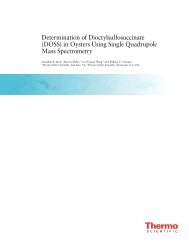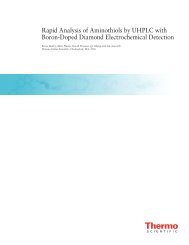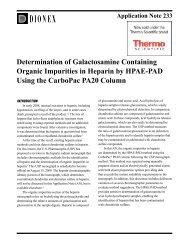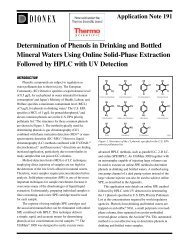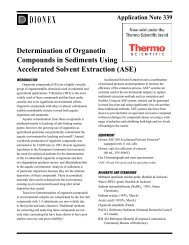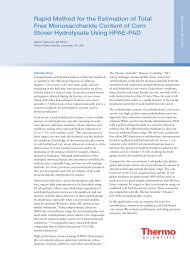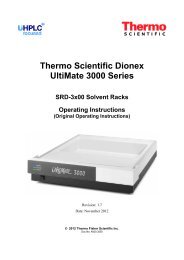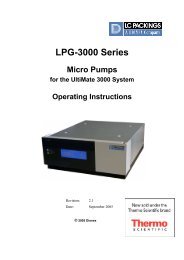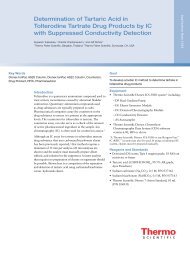Analysis of Fat-Soluble Vitamins and Antioxidants in ... - Dionex
Analysis of Fat-Soluble Vitamins and Antioxidants in ... - Dionex
Analysis of Fat-Soluble Vitamins and Antioxidants in ... - Dionex
Create successful ePaper yourself
Turn your PDF publications into a flip-book with our unique Google optimized e-Paper software.
Now sold under the<br />
Thermo Scientific br<strong>and</strong><br />
AbstrAct<br />
<strong>Analysis</strong> <strong>of</strong> <strong>Fat</strong>-<strong>Soluble</strong> <strong>Vitam<strong>in</strong>s</strong> <strong>and</strong> <strong>Antioxidants</strong><br />
<strong>in</strong> Supplements by RP-HPLC<br />
Marc Plante, Chris Crafts, Bruce Bailey, Paul Gamache, John Waraska, <strong>and</strong> Ian Acworth<br />
ESA—A <strong>Dionex</strong> Company, Chelmsford, MA, USA<br />
<strong>Fat</strong>-soluble vitam<strong>in</strong>s (FSVs) <strong>and</strong> fat-soluble antioxidants (FSAs) play<br />
essential roles <strong>in</strong> a wide spectrum <strong>of</strong> biochemical <strong>and</strong> physiological<br />
processes. Vitam<strong>in</strong> E (tocopherol) along with other FSAs (e.g., carotenoids<br />
<strong>and</strong> coenzyme Q10 [CoQ10]) are purported to help mitigate the effects<br />
<strong>of</strong> oxidative stress that have been l<strong>in</strong>ked to numerous diseases, <strong>in</strong>clud<strong>in</strong>g<br />
cancer, neurodegeneration, <strong>and</strong> atherosclerosis. These compounds are<br />
thought to exert their beneficial effects by act<strong>in</strong>g as cha<strong>in</strong>-break<strong>in</strong>g<br />
antioxidants, <strong>in</strong>hibit<strong>in</strong>g lipid peroxidation <strong>of</strong> polyunsaturated fatty acids<br />
(PUFAs) conta<strong>in</strong>ed with<strong>in</strong> biological membranes, thereby prevent<strong>in</strong>g the<br />
formation <strong>of</strong> potentially cytotoxic <strong>and</strong> highly reactive aldehydes. Shown<br />
here is a simple, reversed-phase high-performance liquid chromatography<br />
(RP-HPLC)-charged-aerosol-detection method for the measurement <strong>of</strong><br />
11 FSVs <strong>and</strong> FSAs <strong>in</strong> commercially-available supplements <strong>in</strong>clud<strong>in</strong>g: vitam<strong>in</strong>s<br />
A (trans-ret<strong>in</strong>ol, ret<strong>in</strong>yl acetate, <strong>and</strong> palmitate), E (a-, d-, g-tocopherols<br />
<strong>and</strong> succ<strong>in</strong>ate), D, <strong>and</strong> K1 (phylloqu<strong>in</strong>one); lycopene; lute<strong>in</strong>; <strong>and</strong><br />
CoQ10. The analysis was completed <strong>in</strong> 20 m<strong>in</strong>. Correlation coefficients<br />
were > 0.999. Limit <strong>of</strong> quantitation (LOQ) values were < 30 ng on<br />
column. This method is an enhancement over current analytical<br />
approaches (e.g., UV <strong>and</strong> evaporative-light-scatter<strong>in</strong>g detection, ELSD)<br />
<strong>and</strong> <strong>of</strong>fers a simple means <strong>of</strong> quantify<strong>in</strong>g FSVs <strong>and</strong> FSAs <strong>in</strong> supplements<br />
<strong>and</strong> foods. Recovery values from commercial products show the<br />
quantitative capacity <strong>of</strong> this method.<br />
IntroductIon<br />
FSVs are typically measured us<strong>in</strong>g UV absorbance or fluorescence.<br />
However, as they conta<strong>in</strong> a variety <strong>of</strong> chromophores, several different<br />
wavelengths are needed for sensitive measurement. This can significantly<br />
<strong>in</strong>crease the complexity <strong>of</strong> analysis. An alternative normal-phase HPLC<br />
method showed that UV absorption at 280 <strong>and</strong> 295 nm was less<br />
sensitive 1 than the HPLC-charged-aerosol-detection method. The<br />
fluorescence detection <strong>of</strong> tocopherol analytes had a wide range <strong>of</strong> relative<br />
response factors, rang<strong>in</strong>g from 1.00 to 2.30. 2<br />
Another universal method uses ELSD, but this detector lacks sensitivity<br />
<strong>and</strong> has a sigmoidal calibration curve over a relatively short range <strong>of</strong><br />
concentrations. A plot <strong>of</strong> analyte peak area versus amount on column<br />
is relatively flat at the upper <strong>and</strong> lower end <strong>of</strong> the <strong>in</strong>strument’s range,<br />
result<strong>in</strong>g <strong>in</strong> poor accuracy <strong>and</strong> precision. This limits the <strong>in</strong>strument’s<br />
use with low-concentration analytes.<br />
Mass spectrometry has the sensitivity for low-level concentrations,<br />
but it is a nonl<strong>in</strong>ear detector, which is expensive to operate for simple<br />
quantitation.<br />
The Charged Aerosol Detector (CAD ® ) is a sensitive, mass-based<br />
detector especially well suited for the determ<strong>in</strong>ation <strong>of</strong> nonvolatile<br />
analytes. For the quantitation <strong>of</strong> FSVs <strong>and</strong> carotenoids, the Corona ®<br />
ultra detector <strong>of</strong>fers high precision, typically < 3% RSD, <strong>and</strong> high<br />
sensitivity, with limit <strong>of</strong> detection (LOD) values < 10 ng on column.<br />
Us<strong>in</strong>g this detector, an RP-HPLC method is shown to successfully<br />
resolve 11 FSV <strong>and</strong> carotenoid st<strong>and</strong>ards <strong>in</strong> < 20 m<strong>in</strong>. Three commercially<br />
available products were prepared <strong>and</strong> quantified, show<strong>in</strong>g good recovery<br />
values based on amounts <strong>in</strong>dicated on the product labels. Early data shows<br />
that this method is capable <strong>of</strong> measur<strong>in</strong>g vitam<strong>in</strong> D (not shown) <strong>and</strong><br />
a-tocopherol succ<strong>in</strong>ate, which is a component <strong>of</strong> the commercial products.
ExpErImEntAl<br />
Charged Aerosol Detection Parameters<br />
Gas: 35.0 psi (nitrogen generator)<br />
Filter: High<br />
Nebulizer Heater: 30 °C<br />
HPLC Parameters<br />
Mobile Phase A: Methanol/water/acetic acid (750:250:4)<br />
Mobile Phase B: Acetonitrile/methanol/tetrahydr<strong>of</strong>uran/acetic<br />
acid (500:375:125:4)<br />
Gradient: Time %A %B<br />
0.00 70.0 30.0<br />
1.00 50.0 50.0<br />
5.00 40.0 60.0<br />
10.00 35.0 65.0<br />
12.00 10.0 90.0<br />
17.00 0.0 100.0<br />
17.10 70.0 30.0<br />
20.00 70.0 30.0<br />
Flow Rate: 1.5 mL/m<strong>in</strong><br />
Run Time: 20 m<strong>in</strong><br />
HPLC Column: Halo ® C8, 150 × 4.6 mm, 2.7 µm<br />
Column Temp.: 40 °C<br />
Sample Temp.: 10 °C<br />
Injection Volume: 10 µL<br />
Sample Preparation<br />
St<strong>and</strong>ards were dissolved <strong>in</strong> ethanol/butylated hydroxyanisole (10 mg/L;<br />
BHA) to the appropriate concentrations. The solid products (CoQ10 <strong>and</strong><br />
Solgar VM-75 ® ) were crushed <strong>and</strong> extracted <strong>in</strong> methanol/chlor<strong>of</strong>orm<br />
(3:5) <strong>in</strong> a sonicator. The supernatant was centrifuged to remove<br />
particulates <strong>and</strong> then diluted appropriately <strong>in</strong> the EtOH/BHA solution.<br />
The natural vitam<strong>in</strong> E product conta<strong>in</strong><strong>in</strong>g 400 IU (268 mg) <strong>of</strong><br />
naturally based a-tocopherol (gelcap form) was dissolved <strong>in</strong> warm<br />
water, extracted <strong>in</strong> diethyl ether, <strong>and</strong> diluted with EtOH/BHA solution.<br />
cAlIbrAtIon plots<br />
2 Optimization <strong>Analysis</strong> <strong>of</strong> <strong>Fat</strong>-<strong>Soluble</strong> <strong>of</strong> the Separation <strong>Vitam<strong>in</strong>s</strong> Power <strong>and</strong> <strong>Antioxidants</strong> <strong>of</strong> 1-D Nano LC <strong>in</strong> Supplements <strong>Analysis</strong> <strong>of</strong> Proteomics by RP-HPLC Samples<br />
Calibration plots are presented here, rang<strong>in</strong>g from 5–333 ng on column<br />
(Figure 1) <strong>and</strong> from 4.8–323 ng on column (Figure 2). All RSDs were<br />
< 5% for all concentrations > 20 ng on column (with an exception <strong>of</strong><br />
lycopene which exhibited front<strong>in</strong>g, thereby reduc<strong>in</strong>g its response relative<br />
to other FSVs).<br />
As seen <strong>in</strong> Table 1, LOD values (2–4 ng on column) were lower than<br />
those for tocopherols by HPLC-UV (10–20 ng on column). 1<br />
The range <strong>of</strong> relative response factors for tocopherols varied from 1.00<br />
to 1.43 at 333 ng on column. This is 60% lower than for variance found<br />
us<strong>in</strong>g fluorescence detection, 2 <strong>in</strong>dicat<strong>in</strong>g that the charged aerosol<br />
detector responses are more uniform across this range <strong>of</strong> compounds.<br />
Table 1. LOD <strong>and</strong> LOQ Values<br />
FSV or Carotenoid LOD (ng) LOQ (ng)<br />
trans-Ret<strong>in</strong>ol 2 7<br />
Ret<strong>in</strong>yl acetate 7 23<br />
Lute<strong>in</strong> 4 15<br />
d-Tocopherol 2 6<br />
a-Tocopherol succ<strong>in</strong>ate 2 6<br />
g-Tocopherol 2 5<br />
Phylloqu<strong>in</strong>one 3 8<br />
a-Tocopherol 4 12<br />
Lycopene 12 40<br />
Ret<strong>in</strong>yl palmitate 3 9<br />
CoQ10 4 13<br />
Peak Area<br />
300<br />
0<br />
trans-Ret<strong>in</strong>ol δ-Toc. γ-Toc. α-Toc.<br />
Lycopene Ret<strong>in</strong>yl palmitate α-Toc. succ.<br />
0 50<br />
100 150 200 250 300 350<br />
Amount on Column (ng)<br />
Figure 1. Calibration curves for seven FSVs by RP-HPLC (5 to 333 ng on column).<br />
26945
Peak Area<br />
180<br />
0<br />
Ret<strong>in</strong>yl acetate Lute<strong>in</strong><br />
Vitam<strong>in</strong> K1 CoQ10<br />
0 50 100 150 200 250 300 350 400<br />
Amount on Column (ng)<br />
Figure 2. Calibration curves for four FSVs by RP-HPLC (4.8 to 323 ng on column).<br />
cHromAtoGrAms<br />
30<br />
pA<br />
-2<br />
0.0 2.5<br />
1<br />
2 3<br />
5.0<br />
1. trans-Ret<strong>in</strong>ol<br />
2. Ret<strong>in</strong>yl acetate<br />
3. Lute<strong>in</strong><br />
4. δ-Tocopherol<br />
5. γ-Tocopherol<br />
5<br />
4<br />
7<br />
7.5<br />
10.0<br />
M<strong>in</strong>utes<br />
6. Phylloqu<strong>in</strong>one (K ) 1<br />
7. α-Tocopherol<br />
8. Lycopene<br />
9. Ret<strong>in</strong>yl palmitate<br />
10. CoQ10<br />
9<br />
Figure 3. RP-HPLC chromatogram <strong>of</strong> FSV st<strong>and</strong>ards (166 ng on column,<br />
vitam<strong>in</strong> K 1 at 66 ng).<br />
30<br />
pA<br />
-2<br />
0.0 2.5<br />
Peaks:<br />
5.0<br />
1<br />
7.5<br />
6<br />
10.0<br />
M<strong>in</strong>utes<br />
Figure 4. RP-HPLC chromatogram <strong>of</strong> the CoQ10-vitam<strong>in</strong> E product (blue)<br />
overlaid with FSVs st<strong>and</strong>ard chromatogram (p<strong>in</strong>k; 166 ng on column, vitam<strong>in</strong> K 1<br />
at 66 ng).<br />
8<br />
12.5<br />
15.0<br />
10<br />
17.5<br />
Peaks:<br />
1. δ-Tocopherol succ<strong>in</strong>ate<br />
2. CoQ10<br />
12.5<br />
15.0<br />
2<br />
17.5<br />
26946<br />
20.2<br />
28616<br />
20.2<br />
28617<br />
pA<br />
-2<br />
0.0 2.5 5.0<br />
Figure 5. RP-HPLC chromatogram <strong>of</strong> Solgar VM-75 product (blue) overlaid with<br />
FSVs st<strong>and</strong>ard chromatogram (p<strong>in</strong>k; 166 ng on column, vitam<strong>in</strong> K 1 at 66 ng).<br />
20<br />
30<br />
-2<br />
6.0 6.5 7.0<br />
7.5 10.0<br />
M<strong>in</strong>utes<br />
Figure 6. RP-HPLC chromatogram <strong>of</strong> natural vitam<strong>in</strong> E product (blue) overlaid<br />
with FSVs st<strong>and</strong>ard chromatogram (p<strong>in</strong>k; 166 ng on column, vitam<strong>in</strong> K 1 at 66 ng)<br />
on different days.<br />
dIscussIon And conclusIons<br />
1<br />
Peaks:<br />
1. δ-Tocopherol succ<strong>in</strong>ate<br />
The method presented here shows good selectivity for many different<br />
fat-soluble vitam<strong>in</strong>s <strong>and</strong> antioxidants, resolv<strong>in</strong>g a total <strong>of</strong> 10 different<br />
compounds (<strong>in</strong> order <strong>of</strong> elution): trans-ret<strong>in</strong>ol, ret<strong>in</strong>yl acetate, lute<strong>in</strong>,<br />
d-tocopherol, g-tocopherol, phylloqu<strong>in</strong>one, a-tocopherol, lycopene,<br />
ret<strong>in</strong>yl palmitate, <strong>and</strong> CoQ10 (seen <strong>in</strong> Figure 3). Other FSV st<strong>and</strong>ards<br />
(analyzed by this method but not shown here) <strong>in</strong>clude cholecalciferol<br />
(vitam<strong>in</strong> D 3 ), a-tocopherol succ<strong>in</strong>ate, <strong>and</strong> β-carotene. Vitam<strong>in</strong> D,<br />
both D 2 <strong>and</strong> D 3 , was found to elute before trans-ret<strong>in</strong>ol. a-Tocopherol<br />
succ<strong>in</strong>ate was found to elute before g-tocopherol as seen <strong>in</strong> Figures<br />
4 <strong>and</strong> 5. β-Carotene was found to coelute with ret<strong>in</strong>yl palmitate under<br />
these conditions.<br />
St<strong>and</strong>ards prepared directly from solids were diluted <strong>in</strong>to FSV solutions<br />
<strong>and</strong> used for this study. From these solutions, calibration curves <strong>of</strong> each<br />
FSV were generated. The result<strong>in</strong>g calibration plots are presented <strong>in</strong><br />
Figure 1 (5–333 ng on column) <strong>and</strong> Figure 2 (4.8–323 ng on column)<br />
show<strong>in</strong>g second-order polynomial fits. Correlation coefficients ranged<br />
from 0.994 (lycopene) to 0.999, <strong>in</strong>dicat<strong>in</strong>g sufficient accuracy for<br />
quantitative work.<br />
12.5<br />
1<br />
15.0<br />
17.5<br />
Peaks:<br />
1. δ-Tocopherol<br />
20.2<br />
28618<br />
7.5 8.0 8.5 9.0 9.5 10.0<br />
M<strong>in</strong>utes<br />
28619<br />
3
The LOQ values for all analytes evaluated were < 25 ng, exclud<strong>in</strong>g<br />
lycopene. Precision was acceptable for all FSVs, with RSD values < 5%<br />
(n = 3) across all amounts above 20 ng on column. All FSV analytes<br />
showed acceptable peak shapes, with the exception <strong>of</strong> lycopene, which<br />
exhibited front<strong>in</strong>g on this column.<br />
A chromatogram conta<strong>in</strong><strong>in</strong>g 166 ng <strong>of</strong> st<strong>and</strong>ards (Figure 3) is overlaid<br />
with each <strong>of</strong> the three products prepared <strong>and</strong> analyzed, as seen <strong>in</strong><br />
Figures 4–6.<br />
Three commercially available FSV products were processed to quantify<br />
FSV content <strong>and</strong> results were compared to those <strong>in</strong>dicated on the label.<br />
The percent recovery values based on label claim are seen <strong>in</strong> Table 2.<br />
The method presented here provides a means for the determ<strong>in</strong>ation <strong>of</strong><br />
FSVs <strong>in</strong> commonly available products.<br />
Passion. Power. Productivity.<br />
dionex corporation<br />
1228 Titan Way<br />
north America<br />
U.S. / Canada (847) 295-7500<br />
P.O. Box 3603<br />
Denmark (45) 36 36 90 90 France (33) 1 39 30 01 10 Germany (49) 6126 991 0<br />
4 Optimization <strong>Analysis</strong> <strong>of</strong> <strong>Fat</strong>-<strong>Soluble</strong> <strong>of</strong> the Separation <strong>Vitam<strong>in</strong>s</strong> Power <strong>and</strong> <strong>Antioxidants</strong> <strong>of</strong> 1-D Nano LC <strong>in</strong> Supplements <strong>Analysis</strong> <strong>of</strong> Proteomics by RP-HPLC Samples<br />
Sunnyvale, CA<br />
94088-3603<br />
(408) 737-0700<br />
Table 2. Label Claim % Recoveries for Products<br />
Product a-Tocopherol Succ<strong>in</strong>ate a-Tocopherol CoQ10<br />
CoQ10-Vitam<strong>in</strong> E<br />
Solgar VM-75<br />
south America<br />
Brazil (55) 11 3731 5140<br />
Europe<br />
Label: 112 mg, 100 IU<br />
Found: 113 mg, 101%<br />
Label: 169 mg,150 IU<br />
Found: 153 mg, 98%<br />
Natural Vitam<strong>in</strong> E N/A<br />
Austria (43) 1 616 51 25 Benelux (31) 20 683 9768; (32) 3 353 4294<br />
Irel<strong>and</strong> (353) 1 644 0064 Italy (39) 02 51 62 1267 Sweden (46) 8 473 3380<br />
Switzerl<strong>and</strong> (41) 62 205 9966 United K<strong>in</strong>gdom (44) 1276 691722<br />
rEfErEncEs<br />
1. Agilent (U.S.) HPLC for Food <strong>Analysis</strong>- A Primer. 2001 http://www.<br />
chem.agilent.com/Library/primers/Public/59883294.pdf (accessed<br />
August 19, 2010).<br />
2. Garcia-Moreno, M.J.; Vera-Ruiz, E.M.; Fernández-Mart<strong>in</strong>ez, J.M.;<br />
Velasco, L.; Pérez-Vich, B. Genetic <strong>and</strong> Molecular <strong>Analysis</strong> <strong>of</strong> High<br />
Gamma-Tocopherol Content <strong>in</strong> Sunflower. Crop Sci. 2006, 46,<br />
2015–2021.<br />
N/A<br />
CAD <strong>and</strong> Corona are registered trademarks <strong>and</strong> ultra is a trademark <strong>of</strong> <strong>Dionex</strong> Corporation.<br />
Halo is a registered trademark <strong>of</strong> Advanced Materials Technology, Inc.<br />
VM-75 is a registered trademark <strong>of</strong> Solgar, Inc.<br />
Asia pacific<br />
Australia (61) 2 9420 5233 Ch<strong>in</strong>a (852) 2428 3282 India (91) 22 2764 2735<br />
Japan (81) 6 6885 1213 Korea (82) 2 2653 2580 S<strong>in</strong>gapore (65) 6289 1190<br />
Taiwan (886) 2 8751 6655<br />
LPN 2818-01 3/11<br />
©2010 <strong>Dionex</strong> Corporation<br />
www.dionex.com<br />
Label: 200 mg<br />
Found: 145 mg, 73%<br />
N/A N/A<br />
Label: 268 mg, 400 IU<br />
Found: 262 mg, 98%<br />
N/A




